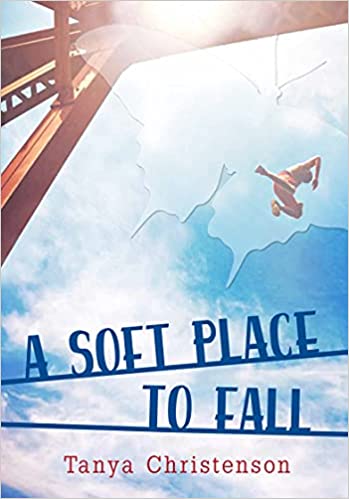A Soft Place to Fall
Genre: dysfunctional family | fiction | teen pregnancy | violence | YA

Author: Tanya Christenson
Publisher: Red Deer Press
When he was five years old, Creighton's mother left. He and his father know she has started a career as a singer but not much more than that. Dad's work with a carnival means they have not set down roots anywhere for long and as a result Creighton does not have a formal education. When they finally settle in a small town, Creighton is 14 years old. When he starts school there, he is placed in an alternate school -- which it turns out is a place for "losers" -- kids who struggle with learning.
Gradually Creighton meets other kids in his new school -- like Schooner who can't read but has his own kind of wisdom and Carin who was a victim of sexual assault when she was thirteen. There is one teacher at the school who truly cares about the students and who encourages their hopes for the future. But when she announces she is leaving at the end of the year, the students feel abandoned. School becomes irrelevant and the students are left to fend for themselves. How will they manage to survive in spite of all the personal disasters that challenge them?
This book tackles some heavy topics: rape, violence, teen pregnancy and family dysfunction. Its theme is resilience, and it’s a gripping read. The characters are distinctive and memorable, and most exhibit solid character growth by the end. The dialogue is authentic, even if the book is more description than conversation-infused.
Ratchet shook his head to the beat, singing along. Schooner stood on the bed and joined in. He grabbed the pillow and pretended he was dancing with a girl, smiling as he belted out each word. Carina and I had never seen this side of Schooner. Out of the blue, Carin reached for my hand and pulled me up from the chair, singing.
Sometimes the description tells rather than shows what’s happening:
Dad rarely asked me questions about my life. When I offered information, hoping for some kind of conversation, he seemed uninterested. He’d go back to reading his paper or watching TV. I was used to dealing with things on my own.
But more often than not, the writing shines:
Carlos had dark greasy hair that stuck out the sides of his black hoodie. His skin was white and pasty, with unhealed sores all around his mouth. Acne scars signaled a battle he had lost all too often, and his Guns N’ Roses hoodie pressed tightly against the rolls of skin that hung over his ripped jeans.
There’s one drawback. Although told from the first-person point of view of Creighton, the anointed teen protagonist, the story is somewhat hijacked. Creighton is heavily overshadowed by an adult character: the teacher who seems to “save” all the misfits who end up in her alternative school.
Heavily admired by her teen students, seemingly perfect, and the penultimate role model of what teachers everywhere should be, Ms. Hays dominates about two-thirds of the book.
I thought about my other schools, the many classrooms and teachers. But I had never had a teacher like Ms. Hay. No one before had made me feel so cared for… No one was as kind as her. No one had ever welcomed me like she did. No one loved their students the way she loved us… Ms. Hay knew how to make us feel good, when nothing else in our lives was working.
It’s almost as if the teen characters are her supporting cast, the better with which to shine the spotlight on her. And of all those teens, Creighton is the least interesting because he has suffered the least childhood trauma.
Young-adult novels need young-adult protagonists and heroes. And those heroes need to be flawed to be believable. When an adult elbows their way into the story – an adult who is portrayed as virtually saint-like – the book begins to lose its young-adult credentials.
It doesn’t help that Creighton is less a protagonist than a narrator throughout, and has no particular flaws himself. The story is filtered through his eyes and ears. His far more interesting classmates’ lives, personalities and antics are related through his senses and presence, yet very little happens to him until near the end, and even there he does not feel like a central character. Nor is he riddled with violent tendencies, overriding sadness or a need to run and hide, like his classmates. He’s not as perfect as Ms. Hays, but he’s bland and steady. It allows him to serve as a counterfoil to the teens suffering around him, but doesn’t quite justify his credentials as the lead character.
Curiously, too, the book begins as Creighton turns five, and it takes several chapters for him to reach his teens. That makes the book read initially like an elementary or middle-grade novel, with the obvious risk that teens will abandon it. Perhaps revealing Creighton’s early life in back-flashes farther into the story would have been wiser.
All that being said, however, the edgy issues are well and bravely handled, and the students are fully drawn and fascinating characters (perhaps with the exception of Creighton). Readers willing to overlook the teacher’s sainthood and Creighton’s low profile will find a compelling read in their hands. This debut author (a teacher and elementary school counsellor) is definitely a writer to watch.
- Pam Withers

